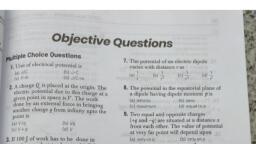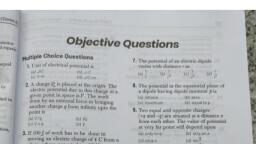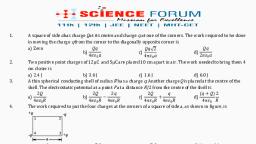Question 1 :
Angle between an equipotential surface and electric lines of force is :
Question 2 :
When moving electron comes closer to other stationary electron, then its kinetic energy and potential energy respectively _____ and _____.
Question 3 :
What is the electric potential at a distance of 9 cm from 3 nC?
Question 5 :
Four identical charges each of charge are placed at the corners of a square. Then at the centre of the square the resultant electric intensity E and the net electric potential V are
Question 6 :
There is no flow of current between two equally charged identical spheres when connected, because, they have the same 
Question 7 :
In a uniform electric field, the potential is $10V$ at the origin of coordinates, and $8V$ at each of the points $(1,0,0),(0,1,0)$ and $(0,0,1)$. The potential at the point $(1,1,1)$ will be:
Question 8 :
A sphere encloses an electric dipole within it. The total flux across the sphere is
Question 9 :
<span class="wysiwyg-font-size-small"><span class="wysiwyg-font-size-small"></span></span><p>Four charges $10^{-8};-2\times 10^{-8};+3\times 10^{-8}$ and $2\times 10^{-8}$ coulombs are placed at the four corners of a square of side $1m$. The potential at the centre of the square is</p><span class="wysiwyg-font-size-small"></span><p></p><p></p>
Question 10 :
Two charges $+q$ and $-q$ are kept apart. Then at any point on the right bisector of line joining the two charges
Question 11 :
Two charges are separated by a distance d. If the distance between them is doubled, how does the electric potential between them change?
Question 12 :
What is the shape of the equipotential surface for the line charge ?
Question 13 :
<span class="wysiwyg-font-size-small"><span class="wysiwyg-font-size-small"></span></span><p class="wysiwyg-text-align-left">If a unit charge is taken from one point to another <span>over an equipotential surface, then</span></p>
Question 15 :
The angle between electric lines of force and equipotential surface is :
























